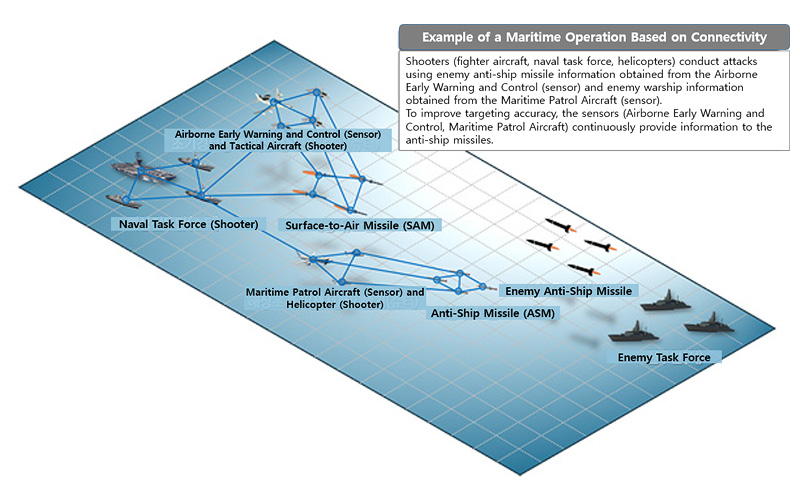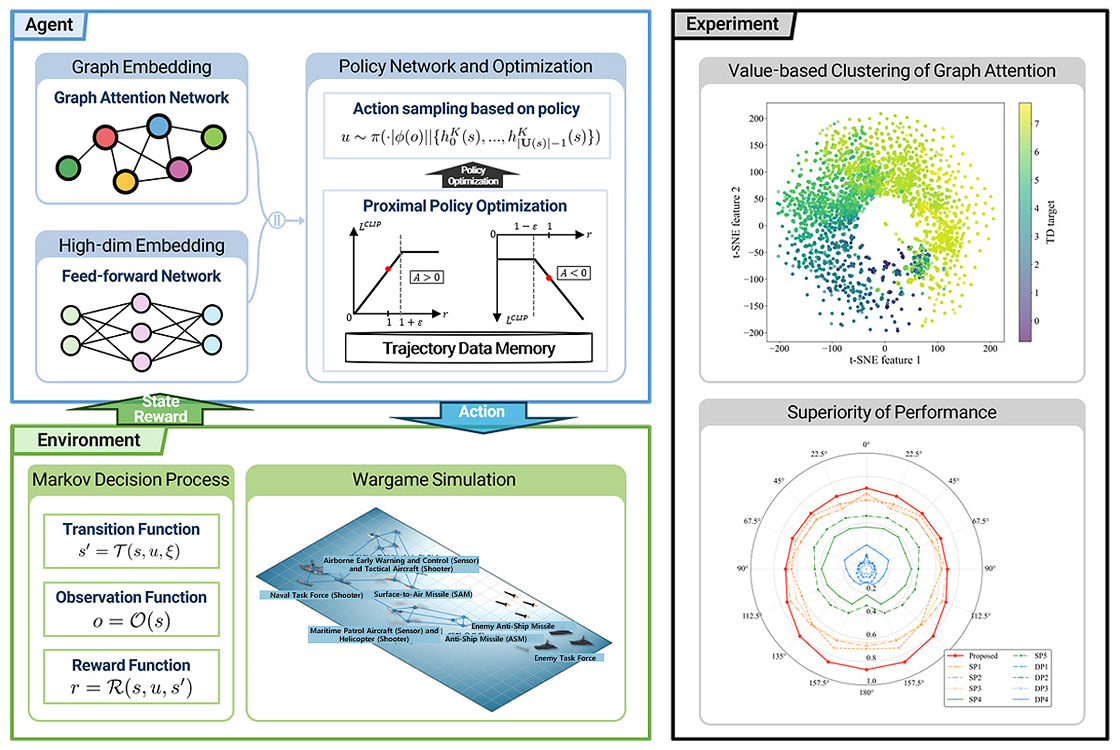Paradigm Shift in Modern Warfare from the Perspective of Weapon-Target Assignment and the Role of Artificial Intelligence
Introduction

Commanders engaged in combat operations must make swift decisions amidst the uncertainties of the battlefield, often referred to as the 'Fog of War.' In such challenging environments, the key to successful operations lies in 'connectivity,' which involves effectively integrating information obtained from all available resources. Modern warfare leverages combat systems and tactical data links to enhance connectivity among ships, aircraft, tanks, unit forces, and guided missiles. This article introduces a decision-making model for Weapon-Target Assignment (WTA) utilizing Graph Neural Networks (GNNs) to improve commanders' decision-making capabilities based on enhanced connectivity. The proposed model effectively analyzes and integrates interactions among numerous sensors and weapon systems in complex battlefield environments, assisting commanders in deriving optimal engagement decisions.
Paradigm Shift in Modern Warfare

The paradigm of modern warfare has evolved from Network-Centric Warfare (NCW) to Decision-Centric Warfare (DCW), and more recently to Mosaic Warfare. NCW aimed to achieve information superiority by networking all elements of the battlefield. DCW focused on deriving rapid and accurate decisions based on this networked environment. Mosaic Warfare emphasizes the resilience of networks, allowing each combat unit to autonomously perform missions even when connectivity is disrupted. Despite differing approaches, "connectivity" remains a core value throughout these developments. Connectivity refers to the real-time information transmission, sharing capabilities, and cooperative systems between sensor systems that collect battlefield information and shooter systems responsible for strikes. This evolution signifies a shift from merely enhancing connectivity to effectively utilizing and analyzing the rich information it provides to qualitatively improve decision-making.
Integrated Combat System and Tactical Data Link
The integrated combat system and tactical data link are core platforms that support commanders' decision-making by integrating sensor and shooter information in real-time on the modern battlefield. These systems collect and analyze battlefield information from various sources to enhance situational awareness, enabling commanders to make optimal decisions. This can be considered one of the most successful applications of the connectivity concept realized through military science and technology.
The integrated combat system primarily performs the role of fusing and integrating sensor information within a single platform, while the tactical data link disseminates and shares this integrated information in real-time between combat systems. Through this, commanders are able to optimally operate available combat power based on a unified battlefield situational awareness. Recently, it has been evolving into a data-driven advanced decision support system through integration with artificial intelligence technologies.
Weapon Target Assignment Problem
The main decisions on the battlefield are divided into two types: maneuver decisions and attack target selection. Among these, the Weapon Target Assignment (WTA) problem is particularly important as it is directly related to the survivability of warships and weapon systems. WTA is essentially a probabilistic discrete dynamic control problem, and the decision (control) variable is the selection of the target to be attacked. In actual combat environments, this problem is governed by various factors:
- The missile guidance process
- The number of missiles and detection capabilities of warships
- Reflective characteristics (Radar Cross Section; RCS) due to the shape of warships
- Kinematic characteristics of warships
- Capabilities of the combat system
Although it is possible to simplify and express these factors in mathematical models, high levels of realism are essential to apply them to actual integrated combat systems or tactical data links and support commanders' decision-making. For this, the use of sophisticated wargame models such as engagement-level simulation models is very important.
Optimization of Weapon Target Assignment Based on Graph and Deep Reinforcement Learning
Recently, a new approach combining Graph Neural Networks and deep reinforcement learning has been gaining attention. Advances in combat systems and tactical data link technologies have exponentially increased the amount of information that can be acquired on the battlefield. However, the ability to effectively utilize this increased volume of information still remains at a declarative level.
Graph-based processing is an innovative technology that can convert this massive information into actual operational capability enhancement and optimized decision-making. Especially, Graph Attention Networks (GAT), based on the attention mechanism, learn to selectively extract and use information according to importance in complex interactions represented as a graph. GAT expresses the relationships between nodes (battlefield elements) as weights and learns these weights to focus on more important information depending on the situation. For example, at a specific moment, it can assign higher weights to more threatening targets to determine priority. This selective attention mechanism enables effective decision-making through goal-oriented situational awareness in complex battlefield environments.
These graph neural networks are combined with Proximal Policy Optimization (PPO)-based reinforcement learning to demonstrate even more powerful performance. PPO is an algorithm that allows stable learning by limiting abrupt policy changes during the policy optimization process. This is a crucial characteristic given the high uncertainty and complexity of battlefield environments. The model experiences various battlefield situations in a simulation environment and gradually improves its policy through rewards based on each action (engagement decision). The clipping mechanism of PPO prevents performance degradation due to drastic policy changes, making stable operation in real-world environments possible.
Furthermore, this combined system enables optimization from a long-term perspective. In other words, it allows decision-making that considers not only the current engagement situation but also future developments. This overcomes the short-sightedness of existing rule-based approaches or simple heuristic methods and enables the establishment of more effective engagement strategies throughout the entire operation process. In addition, this system is capable of flexible responses to enemy tactical changes or unexpected situations and has the characteristic of gradually improving performance through continuous learning.
The proposed WTA framework combining graph neural networks and reinforcement learning and its experimental results show two noteworthy outcomes as seen in "Figure 2". First, value-based clustering analysis reveals that the relationships between combat elements according to battlefield situations are clearly clustered based on the qualitative level (color) of decision-making. This implies that the proposed method provides discernment for selecting optimal decisions. Second, the performance superiority analysis shows that the proposed method (red line) achieved superior performance across all areas compared to other existing techniques.

Conclusion
In modern warfare, the importance of connectivity has continued to grow, and this has been embodied through the development of integrated combat systems and tactical data links. However, effectively utilizing the increased volume of information to derive qualitatively enhanced decision-making remains a significant challenge. The weapon target assignment decision-making model based on graph neural networks and reinforcement learning proposed in this study presents an innovative solution to this challenge.
In particular, the selective attention mechanism of the graph neural network and the stable learning characteristics of PPO reinforcement learning enable rapid and effective decision-making required in complex battlefield environments. This holds great significance in that it goes beyond simple information integration to realize intelligent use of information considering situational context and the establishment of strategies from a long-term perspective.
The methodology proposed in this study is expected to be applied as a core element of future intelligent combat systems and to serve as a practical tool that supports rapid and effective decision-making on the battlefield.